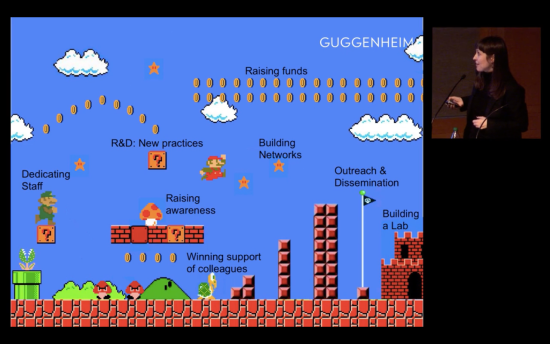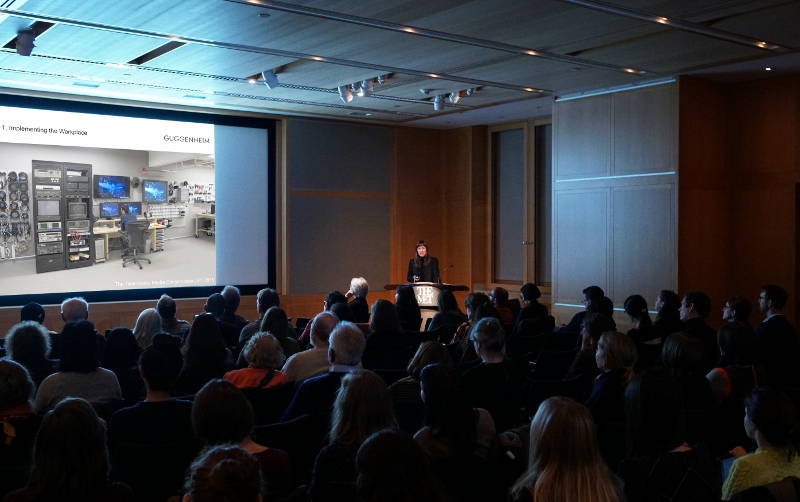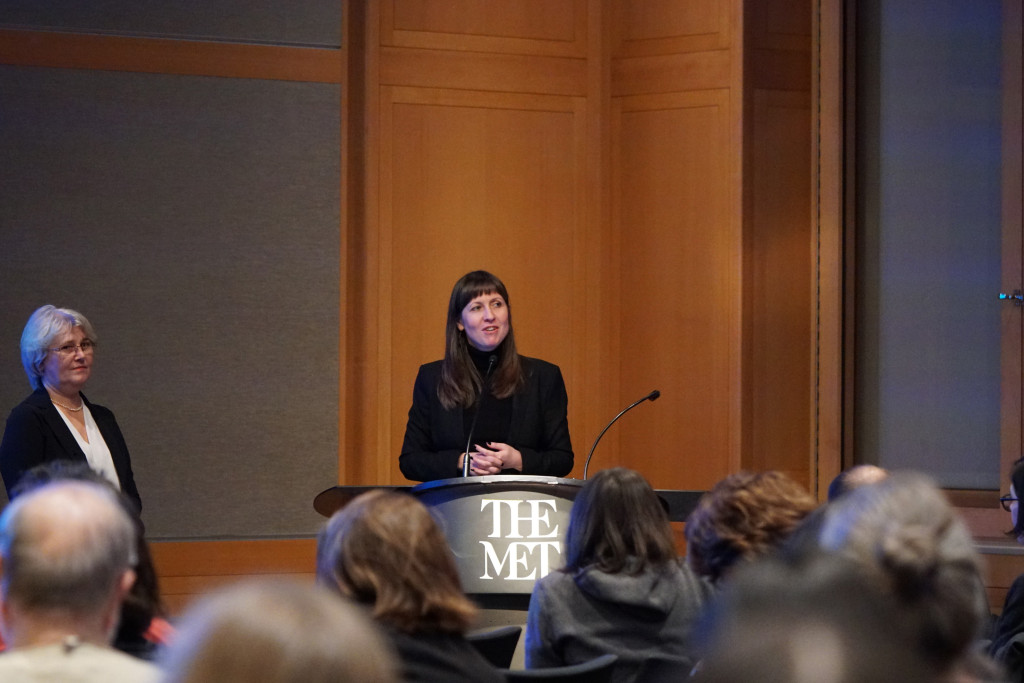This week’s contributing blogger, Sofia Kofodimos, is an M.A. student at the Institute of Fine Arts, NYU and a project cataloger at the Museum of Modern Art Archives. She previously worked on archival projects at Fales Library & Special Collections, The Emily Harvey Foundation, The Robert Wilson Archive, and was a Gallery Guide at the Solomon R. Guggenheim Museum.
In her recent lecture “Implementing Time-Based Media Conservation in Museum Practice”, Joanna Phillips, Senior Conservator of Time-Based Media (TBM) at the Guggenheim Museum, presented practical strategies for gaining institutional support and funding for TBM conservation and its staff, equipment, and procedures. Drawn from her experience as a first-generation TBM conservator, Phillips discussed how she established the media conservation lab at the Guggenheim, the skills required to get the job done, and the importance of collaborating with internal and external networks.
Phillips began by tracking the development of the Guggenheim’s TBM conservation lab, from its surprisingly modest origins as a small cart of equipment in 2008 to the impressive and well-equipped lab it is today. By openly discussing the challenges she faced, like the “must change moments” and inconveniences of a temporary workspace in a spray booth, Phillips made the process of constructing a TBM conservation lab seem less daunting and thus possible for smaller institutions. In 2015, she collaborated with colleagues in other museum departments—designers, electricians, engineers, and fabricators—to design and construct the new lab which features a video viewing station as well as adaptable design components like wheeled tables, blinds for dividing space into screening areas, and extra desks for future staff as the department grows.
According to Phillips, one of the most difficult aspects of implementing TBM conservation is convincing museums to hire dedicated media conservators when they have relatively few TBM artworks in their collections compared to the number of works in traditional media like painting, drawing, and sculpture. Despite being few in numbers, TBM artworks are precarious and require more labor-intensive assessments and treatments, careful storage, and more extensive documentation than most other artworks because e.g. all of their media must be checked for quality, videos watched, and all components documented and understood in context.
Phillips proposed several alternative staffing solutions for institutions that cannot yet hire a full-time media conservator including: contract conservators and other specialists, project-based hires, working with conservation students, fellows, and interns, and cooperating with experts in-house and with other museums. The work of these temporary staff will help spread institutional awareness and gain leverage for acquiring funding by articulating concrete situations that need to be resolved.
Due to the complex and heterogeneous nature of media artworks, TBM conservators must have a wide range of skills such as familiarity with scientific and academic research, video technologies, digitization, computer coding, custom hardware, electronics, and much more. It is impossible for one person to be an expert in all these areas, so the field of TBM conservation is inherently collaborative. These conservators also must be spokespeople for the preservation of the collections in their custody and eager to continue learning new specialized skills. Because the field is still defining workflows for best practice, spreading awareness about the appropriate storage and treatment procedures of these artworks is another key task of TBM conservators. To articulate this point Phillips humorously compared not having proper storage for digital artworks to storing a painting by Picasso in a damp and filthy garage.
In addition to learning specialized skills, collaboration with both internal and external networks is a fundamental aspect of implementing TBM conservation. Within the Guggenheim, Phillips often works with exhibition curators, A/V technicians, designers, educators, and other conservators to make decisions like which projectors to use, the wall colors, and placement of various components of an artwork during the process of installation. Documenting these decisions is an important aspect of Phillips’s “Iteration Reports,” which are designed to help future conservators and curators understand how to install these artworks and the reasoning behind certain aspects of the decisions made. Phillips also discussed the importance of collaborating with external networks such as her work with Dr. Deena Engel, Professor of Computer Science at NYU, and her students to analyze and document software-based artworks in the Guggenheim’s collection. Outreach programs, workshops, and lectures like the TechFocus conference Phillips co-organized all increase the visibility of TBM conservation, which is vital for the advancement of the field and for funding projects.

Phillips concluded her lecture with a screenshot from the videogame Super Mario Bros, which she marvelously modified to illustrate that the process of implementing TBM conservation in museum practice is not a linear progression. She labeled the rewards in the videogame— the rows of coins, stars and mystery boxes— with goals like dedicating staff, developing new practices, raising funds, and building networks showing that there are numerous possible approaches to achieving the end goal of building a TBM conservation lab and that the route will be different for every museum. The immensely helpful strategies and examples in Phillips’s lecture make it an invaluable resource for professionals and students in the fields of conservation, museums, and art history. This inspiring call to action will raise awareness to ensure that time-based media artworks are adequately stored and conserved for generations to come.
A video of this event is available in the NYU Institute of Fine Arts Vimeo archive: https://vimeo.com/196638937
VoCA is pleased to present this blog post in conjunction with the NYU/IFA Conservation Center’s Topics in Time-Based Media Art Conservation lecture series, which took place during the 2016 Fall semester. The series was organized by Hannelore Roemich and Christine Frohnert and was generously supported by the Andrew W. Mellon Foundation. The full schedule can be found at https://www.nyu.edu/gsas/dept/fineart/events/time-based-media.htm


